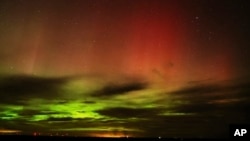An intense solar storm has the northern lights gracing the skies farther south than usual.
A blast of superhot material from the sun late last week hurled scorching gases known as plasma toward Earth at about 3 million kph, the National Oceanic and Atmospheric Administration said Monday.
Earth felt the brunt of the storm Sunday, according to NOAA, with forecasters warning operators of power plants and spacecraft of the potential for disruption.
"I don't want any expectations of these green curtains moving back and forth" so far south, said Bill Murtagh, program coordinator at the NOAA Space Weather Prediction Center in Boulder, Colorado.
Auroras were reported across parts of Europe and Asia. In the U.S., skygazers took in the sights from northern states such as Wisconsin and Washington, but also states farther south, including Colorado, California, New Mexico and even Arizona — mostly a reddish glow instead of the typical green shimmer.
Although conditions have eased, auroras might still be visible as far south as South Dakota and Iowa late Monday and early Tuesday if skies are dark.
The farther north, the better the chance of a show as the energized particles interact with the atmosphere closer to Earth, according to Murtagh. The farther south, the curvature of the Earth cuts off the possibility for the most dazzling scenes as the particles interact higher in the atmosphere.
Murtagh said light pollution in Boulder prevented him from seeing the auroras Sunday night. But there could be more opportunities as the solar cycle ramps up.
"Stay tuned, more to come," he said.
This was the third severe geomagnetic storm since the current 11-year solar cycle began in 2019, according to NOAA. The agency expects the cycle to peak in 2024.
For those Down Under, the southern lights should provide equally good shows, Murtagh said.







